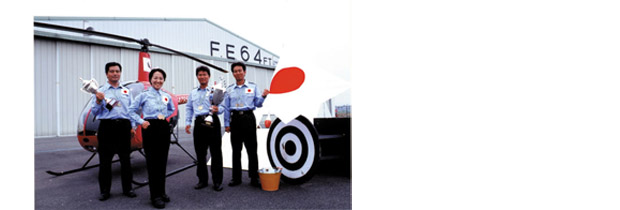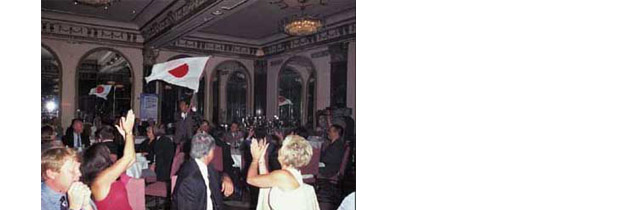SHIZUKA’S STORY
Back in 1985 how many people expected a young girl to one day establish her own aviation company? In those days, there was no woman president of any aviation company in Japan, and women had no chance to get a job as a pilot: even men had few opportunities at that time.
The situation has slowly been changing and the Japan Self Defense Force now even trains women pilots.
 In 1980, I married Kenji Saito. We were 23 years old, but had met each other four years before at the university. We decided to go South Africa for our honeymoon. Our trip to Victoria Falls made a deep and lasting impression on me.
In 1980, I married Kenji Saito. We were 23 years old, but had met each other four years before at the university. We decided to go South Africa for our honeymoon. Our trip to Victoria Falls made a deep and lasting impression on me.
Kenji and I joined a sight-seeing flight tour in what may have been an Apache with two Germans and a British pilot. That was our first experience to fly in a small aircraft.
Several years passed and Kenji found an article on flight training in the USA which interested us, and he encouraged me go to the States to get a private airplane license.
I spent three months in California, learned a lot, earned my license, and had a good time. Then I returned to Tokyo and wondered what I could do in the field of aviation as I had only a private license for pleasure flying.
 By chance, a cameraman who took aviation photos here in Japan suggested I work selling amphibious planes to Japanese. I started to sell memberships to a flying club, and I met many people, including an old helicopter instructor who showed me how enjoyable flying a helicopter was. That helicopter was an R22.
By chance, a cameraman who took aviation photos here in Japan suggested I work selling amphibious planes to Japanese. I started to sell memberships to a flying club, and I met many people, including an old helicopter instructor who showed me how enjoyable flying a helicopter was. That helicopter was an R22.
Since then I have been fascinated by the R22. I wanted to start R22 training immediately, but it was so expensive; one hour was the same as the monthly salary of an office girl! I had no money at all to pay for it so I negotiated with the owner of the R22 flying club.
We swapped: I recruited people to join his club or wrote articles for the club and he gave me free flight time. However, there was not enough time to earn my license and I was frustrated with this. In addition, my parents opposed my efforts to get the license. According to Japanese tradition, when women get married they should become housewives and have children as soon as possible. My parents refused to help me in my quest, but destiny sent me a helping hand in the form of a philanthropist who lent me money. I took advantage of the situation to obtain a helicopter license in the United States.
 Upon returning to Japan, I decided to establish my own company and develop my own aviation style. Before long, I ran into another obstacle: a lack of funds. I fought against this and after a while, the CEO of a magazine company introduced me to a businessman who wanted to establish an aviation business for Japanese in the USA. I discussed this with him and he gave me discretionary authority to do as I saw fit. I went back to Japan, and opened my company and “headhunted’ my husband.
Upon returning to Japan, I decided to establish my own company and develop my own aviation style. Before long, I ran into another obstacle: a lack of funds. I fought against this and after a while, the CEO of a magazine company introduced me to a businessman who wanted to establish an aviation business for Japanese in the USA. I discussed this with him and he gave me discretionary authority to do as I saw fit. I went back to Japan, and opened my company and “headhunted’ my husband.
Finally, I persuaded him to come on board. I had the perfect employee! To start with, we introduced Japanese people to the American way of aviation and brought them to our partner’s school for their private license.
In the mid ’80s in Japan, flying aircraft was not popular so it was not easy to recruit clients. Our business was so slow and after six months, our partner lost interest in this business and Kenji and I decided to go it alone. Slowly, the situation improved.
In summer of 1988 the Japanese economy took off. As a result, the number of customers increased and little by little people purchased helicopters for pleasure and business.
For the next three years, the Japanese economy expanded. Japanese businessmen spent lots of money and purchased land, resorts, famous paintings, and helicopters and even fixed-wings! They did not fly, but just kept such expensive aircraft for tax deductions. In such crazy times, everyday people who wanted to be pilots visited our office. I thought it was strange, just another fad!
There were many temptations along the way. Realtors tempted us to purchase land and condominiums, and bankers tempted us to purchase membership in golf courses, stocks, insurance, etc. We rejected these offers, and instead, concentrated on educating our employees and expanding our company.
In 1988, we established the Robinson Helicopter dealership in Guam and in 1990 we established the Robinson Helicopter Service Center in Japan.
Also we started the complicated task of applying to the Japanese Civil Aviation Bureau. Obtaining a work air operator license was my objective. I think nobody can imagine all the hoops we were forced to jump through.
Usually, Japanese bureaucrats like ‘when you take shelter, make sure you go under a big tree.’ They do not want to deal with small companies, especially those established by a woman.
We faced new challenges and fought many regulations and unwritten rules.
We had to submit our documents to three sections for inspections:
the Maintenance Division, the Operation Division, and Regional Air Operations. The Maintenance Division oversees the careers of mechanics, duties, education and training programs, helicopter maintenance schedules, supply of parts, tools and quality control of all. The Operation Division inspects general flight operations, aircraft and equipment VFR/IFR operating limitations, weather requirements, flight crew member requirements, crew member flight times, duty period limitations and rest requirements. The Regional Air Carrier Division oversees management of the company and market controls.
JCAB did not show us the circular of flight operations so it was very hard to prepare the correct documents. It took three weeks to change only one sentence! They met only two or three times a month for that. Also, they demanded many things and it was virtually impossible to find experienced pilots who met their requirements.
We started this task in 1990 and finally in August 1992,we got our operating license. In April 1993, we started our operation in Hokkaido, in northern Japan. For three years, I paid all salaries without being able to start doing business as an Air Work Operator.
It was a really challenging time. Additionally, by this time the economic bubble in Japan had burst.

 The next year we opened our second operation center in the Kanto area which is located near Tokyo. We had two operation bases.
The next year we opened our second operation center in the Kanto area which is located near Tokyo. We had two operation bases.
Our operation was improving steadily and we established our Robinson dealership in 1998 for R22, and in 2000 for the R44.
Our sales of R22s and R44s continue to be brisk. Alpha Aviation was strengthened by our efforts.
Our company owned two R44, five R22, one SA350, two Schweizer 300CB, one airplane TB21, one TB9, and one Glider LS8.
I enjoy flying these.
 Why do I compete in The World Helicopter Championship? In 1997, British pilots Jennifer Murray and Quentin Smith competed in Round the World in an R44. They asked us to assist their flight through Japan. A mountain of paperwork was required to negotiate with each airport, customs and JCAB officials.
Finally, they succeeded in RTW in 1997.
Why do I compete in The World Helicopter Championship? In 1997, British pilots Jennifer Murray and Quentin Smith competed in Round the World in an R44. They asked us to assist their flight through Japan. A mountain of paperwork was required to negotiate with each airport, customs and JCAB officials.
Finally, they succeeded in RTW in 1997.
We are so proud of assisting their flight. Until we met them, we were not interested in Europe. They gave us the chance to explore new horizons. Jennifer, in particular, encouraged me because she was 57 years old but continued to be successful in flying.
Since meeting Jennifer and Quentin, I wanted to participate in a competition.
I asked Quentin about helicopter championships and he encouraged me and my team to go for it. He already had won a prize so I asked him to come to train us in Japan.
He is always very busy, but in April 1999, he stayed at our heliport for one week to train us.
At first, we could not fly well. But Quentin persevered and trained us well. He suggested we go to Nordlingen, Germany for the World Helicopter Championships. Our first challenge got off the ground. We decided to use our R22 JA7830 so we disassembled it and sent it by airfreight to our friend, Paul’s, house in Germany. Fortunately, Paul had enough tools to reassemble our helicopter.
 Good news!
Good news!
At the WHC, our team comprised of Takashi Tanizawa and Akihiro Sakamoto earned The Gold Medal in Event No. 1, timed arrival. Nobody expected they would win!
We were surprised at this, too, but ecstatic.
We announced the good news to Quentin and Frank Robinson, who were equally thrilled at this news.

 In 2000, we competed again in Spain. We earned good results: Mitsuo Aoyama and I earned one Gold in Event No. 2, precision flying, and one Bronze in Event No. 1, timed arrival, for an overall position of fourth place. Takashi Tanizawa and Akihiro Sakamoto earned one Gold in Event No.4, slalom, and one Silver in Event No. 2, precision flight. They came in second place overall.
In 2000, we competed again in Spain. We earned good results: Mitsuo Aoyama and I earned one Gold in Event No. 2, precision flying, and one Bronze in Event No. 1, timed arrival, for an overall position of fourth place. Takashi Tanizawa and Akihiro Sakamoto earned one Gold in Event No.4, slalom, and one Silver in Event No. 2, precision flight. They came in second place overall.
In August, I competed with Mistuo Aoyama in The German Open Helicopter Championship in Eisenach. We got the fourth position.
I enjoyed flying in Europe and met many fellow flying enthusiasts.
It is a wonderful world event for pilots from all corners of the globe to get together peacefully.
I want to continue to compete in WHC.
Shizuka Saito, Alpha Aviation

